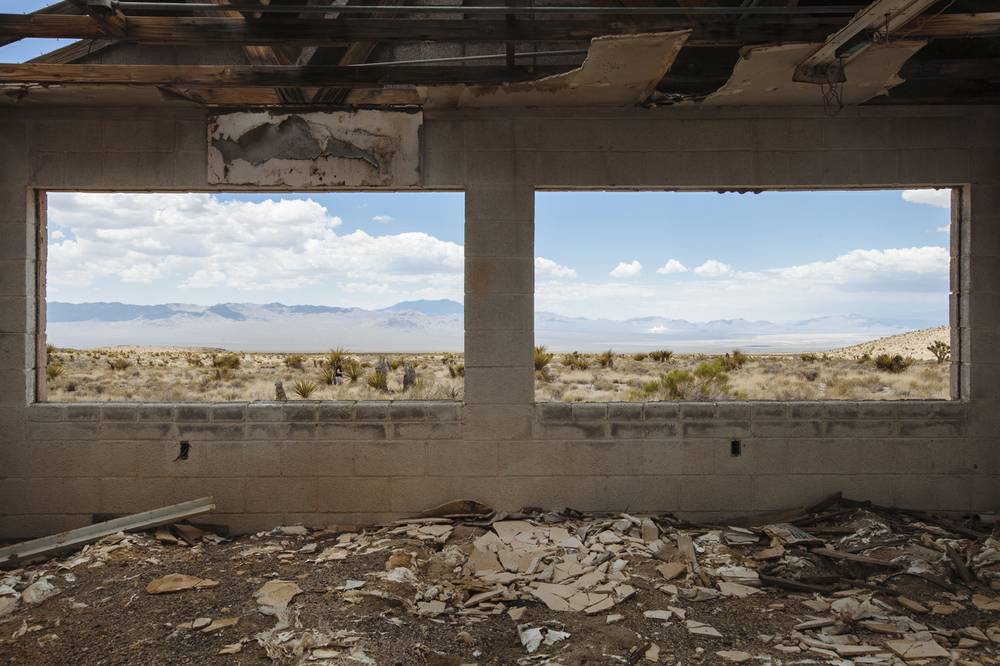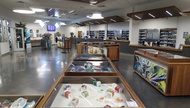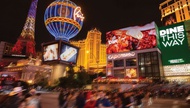Rolling down a broken highway slicing through the oven that is the East Mojave, we stop at every decaying attraction, peer into buildings and trailers, examine rusted pull-tab cans and smashed bottles. The ruins on the otherwise pristine landscape have been here for so long they seem as natural as the miles of creosote framed by jagged mountains. The headliner here is the vast sense of emptiness, the kind that causes ringing in the ears from the near-silence of being miles from anywhere, with the heaviness of the heat sealing us in. No convenience stores, strip malls, neighborhoods or traffic. Just the blazing reflection of the solar towers in the distance.
The Midwest has its prairies and plains. Yosemite has dense wilderness, a cascading sculptural countryside of color and form and flowing water. The Mojave is seen as the anti-Eden, a romanticized rugged wilderness of television Westerns blaring into cooled basements on Saturday afternoons. It’s 100-plus degrees with no shade, but saying it’s hot is like saying water is wet. We rarely discuss it, choosing to absorb the awesomeness of the fragile ecosystem and the remains of past inhabitants as we ramble through the Mojave National Preserve.
There are ghost towns here, and volcanic formations, lava beds, dry lakes, native sites and the historic unpaved Mojave Road. The ancient plutonic rocks of the Granite Mountains are nature’s sculptures, formed millions of years ago, and Kelso Dunes welcomes hikers to the 45-square-mile dune field. We pass the Ivanpah Desert Tortoise Research Facility, but never make it to the Desert Studies Center in Zzyzx. Next time.
In Cima, what was once a trailer home sits on a long flatbed with collapsing tires. Its walls are gone, its ceiling piled on the floor. A broken plastic pony and an empty bottle of Captain Morgan lie on the dusty rose carpet, exposed to the elements. The floral-patterned kitchen tile matches. Someone left this here on the gravel in front of the now-closed Cima general store in the blip of a ghost town on the north/south vein running through the preserve’s 1.6 million acres. By the looks of things, it’s been here a while, as has the nearby bullet-riddled, rusted and collapsed Ford Falcon loaded on top with scrap metal sinking in its roof—just part of the scenery along this expanse between 1-15 and I-40.
We would have stayed all day in Nipton, a gateway at the north edge where we scratched lottery tickets on the patio of the temporarily closed café, ate snacks from the Nipton Trading Post and toured the town, the entirety of which is for sale (including its hotel, solar plant and campground area). But then we’d miss all the treasures in Cima and Kelso and at Roy’s Motel & Cafe in Amboy 18 miles south of the preserve.
The pavement ends on Ivanpah Road, and we backtrack to the Morning Star Mine Road that takes us to Cima, before spilling us into the parking lot of the Kelso Depot Visitor Center. A former train station turned museum with restored dormitory rooms for railroad workers and a ticket and telegraph office, it has been standing since 1924.
Inside the sprawling Spanish-style building we learn about Kelso, an early railroad water stop that became a World War II boomtown. Spread throughout the restored depot are exhibits dedicated to railroad culture, area wildlife, historic maps, rock formations and native Chemehuevi and Mojave tribes. Artist Mary Olin Gieger’s mixed-media installation, “Occupying Memory,” sits in the basement’s Desert Light Gallery. A tapestry curtain of the Providence Mountains hangs above the sculpture’s desk and chair and other objects found roadside. Baskets made of sweater thread and computer wires explore those made by the Chemehuevi tribe. In another room, a scale model of the town offers the complete lay of the land. Upstairs, travelers cool off at the counter of the now-closed diner.
We leave the bookstore with a copy of East Mojave Diary by Bob Ausmus, whose brilliantly colorful stories of the cowboys, rail workers and early homesteaders capture the gritty, hard-working communities that called this area home for decades. Written by the late rancher from Cima, who spent more than 60 years in the East Mojave, the tales are told in the voice of a local wanting to set the record straight by cementing his old newspaper columns into a book. Combined with old photographs and illustrations, its narratives explain what we’ve been wondering about while rambling through the chunk of mostly wilderness, fully lit by the blinding sun.
We flip through its chapters as we pass through the forest of Joshua trees leading to the 40, out of the preserve and to Amboy, where the Googie-style architecture of Roy’s celebrates the fantastic mid-modness off Route 66, announcing itself through its heavily photographed, stunning orange sign. Swiss artist Séverin Guelpa created installations in the freestanding bungalows. Travelers roam in and out, examining the works in “Golden Smile Salty Tears,” which reflect the area through mostly found objects and created pieces touching on fragility and natural elements. Like Geiger’s work back in Kelso, it fits in with the long line of art created here, beginning with the pre-historic petroglyphs still visible in rock.
There is no longer a café at Roy’s, but snacks, sundries and souvenirs fill out the former diner. The floor-to-ceiling windows of the closed-but-still-furnished lobby showcase the retro orange registration desk curtains and decor. Room keys still hang on the wall. A carousel pony is displayed near the window, and a grand piano sits in a sunlit corner.
Pristine ’50s-era cars, parked behind a chain-link fence, line the foreground of the boarded-up town. In the distance there’s a giant faded hot dog and equally large chicken on its side—perhaps early advertising, the kind of constructed sculptural icons designed to draw passing cars.
The boarded school is gated, its grand archway still intact, reminding of the busy years when Roy’s and Amboy boomed with the opening of Route 66. The attendant at Roy’s puts gas in our car as if it’s Mayberry, and we head north on a route that leads us through more of the same with natural attractions on either side.
Driving past the Amboy Crater we realize we spent too much time—and not enough—lingering in Nipton to make any more stops. There’s too much to see out here, too much to do. It’s an organic Disneyland worthy of respect and patience. We’ll come back someday, we decide, drifting into a late-afternoon lull, broken only when we ride over a cattle grate that has the wallop of a triple-stacked speed bump.
We regain our sense of wonder and slowly work our way up to I-15, 50 miles west of Baker. As we head back to Vegas, we know what we’re missing by taking the freeway.







